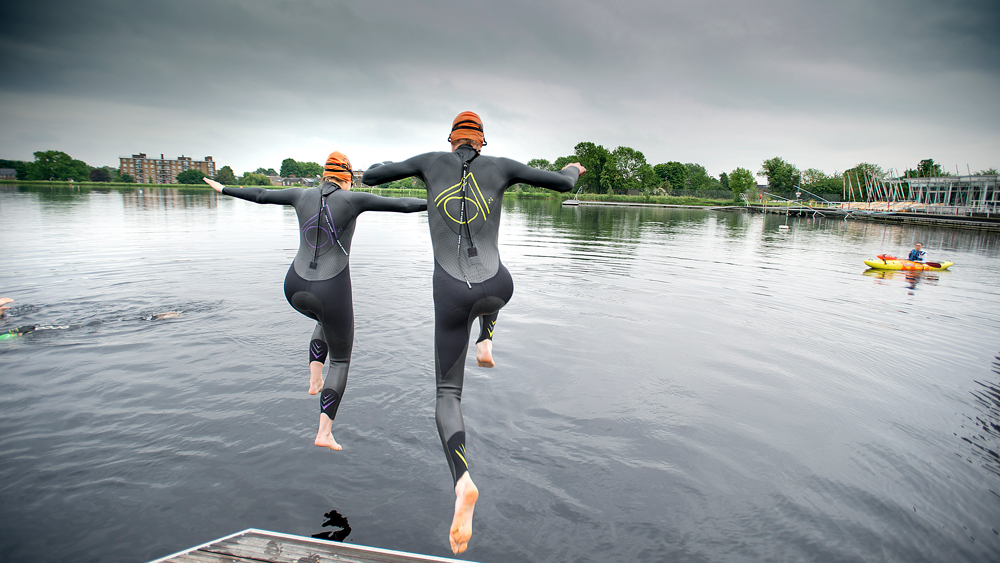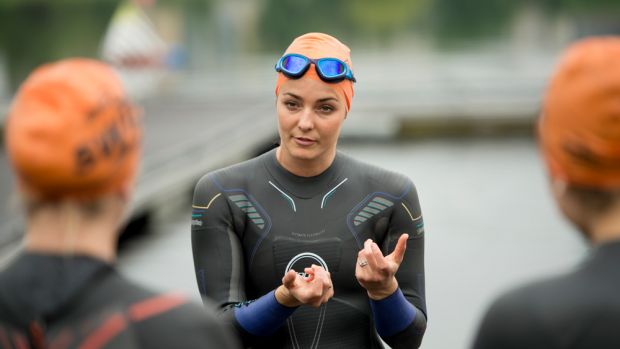Two Insanely Helpful Swimming Technique Tips That’ll Make You Enjoy Front Crawl Again
Just a couple of pointers from Olympian Keri-Anne Payne’s swimming masterclass got us back in the water and eating up the lengths

It’s been a long time since we had a swimming lesson, something in the region of 20 years, so we’ve forgotten pretty much everything we learned. And despite knowing the many benefits of swimming, we make only the occasional foray to our local pool. When we do, we default to breaststroke since our flailing front crawl leaves us gasping for breath after one length.
So we jumped at the chance to get some expert tuition from Keri-Anne Payne, who’s a two-time world champion and Olympic silver medallist in the open-water swimming 10K, the marathon of the swimming world.

Payne’s supporting the Great Swim, an annual summer series of open-water swimming events across the country. Coach is still a long way from getting the skills needed to take to the great outdoors (sighting, the art of looking where you’re going while swimming, remains beyond us for the time being), but we did pick up some easy-to-follow advice that’s got us back in the pool and cranking out lengths using the freestyle stroke.
Here’s what made the difference. Bad news first: you’re going to have to overcome some fundamental human impulses.
1. Body Position
Keeping your body arrow-straight and perfectly horizontal is crucial to making the freestyle stroke efficient – and efficient means easy (well, easier). Unfortunately there’s a crucial survival impulse that royally mucks this up: wanting to see where you’re going. That means your head goes up, which causes your legs to go down, which increases the drag of your body through the water.
Payne once got an engineer friend to do some calculations and they worked out that swimming through the water with sinking legs is equivalent to pulling along an additional third of a ton.
There are two things you can do to overcome this problem. The first is to get familiar with the feeling of being straight. Payne describes it as being similar to cheating on a height test. You’ll have done this – standing back to back with a friend and straining to be as tall as possible (think “giraffe neck”, says Payne). That’s the feeling you’re aiming to replicate – just horizontally.
Get the Coach Newsletter
Sign up for workout ideas, training advice, reviews of the latest gear and more.
To get there when you’re in the pool, look straight down at the bottom – the water should break somewhere around your crown. There’s a sweet spot that takes a bit of experimentation to discover, but once you’ve found it you’ll be amazed at how quickly a length flies by.
2. Breathing
Body position is crucial, but right now your body is probably trying to point out that breathing is the most crucial thing. There’s nothing like being under water to induce the desire to get as much of that sweet, sweet air in your lungs as soon possible the next time you surface. Anyone who’s ever learnt how to scuba dive will know that controlling your breathing under water is one of the hardest things to master.
But as Payne points out, you wouldn’t take a huge breath, hold it, then blow everything out when you run, so this shouldn’t be how you breathe when you swim. Instead you’re looking to breathe calmly – Payne recommends breathing out through the nose, because it’s harder to empty your lungs through your beak.
The more we worked on keeping to relaxed, steady, regular breathing, the more we found our stroke becoming smoother as a byproduct, and we didn’t have to stop to catch our breath every time we touched the side.
There are, of course, many more ways to improve your swimming, but we found these two things made such a big difference to our swimming (and took a fair bit of practice to master) that they provided the perfect motivation to get back in the pool.
RECOMMENDED: An Olympic Triathlete’s Guide To Front Crawl Swimming Technique
If you fancy dipping your toe into the open water visit greatswim.org for more information or to enter an event this summer. The Suunto Great London Swim is staged on Saturday 1st July 2017 at Royal Victoria Dock, entry is open through Wednesday 28th June

Jonathan Shannon was the editor of the Coach website from 2016 to 2024, developing a wide-ranging experience of health and fitness. Jonathan took up running while editing Coach and used the training plans on the site to run a sub-40min 10K, 1hr 28min half marathon and 3hr 6min marathon. He’s an advocate of cycling to work and is Coach’s e-bike reviewer, and not just because he lives up a bit of a hill. He also reviews fitness trackers and other workout gear.









